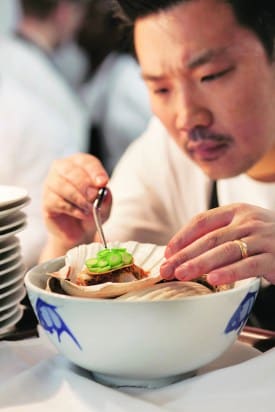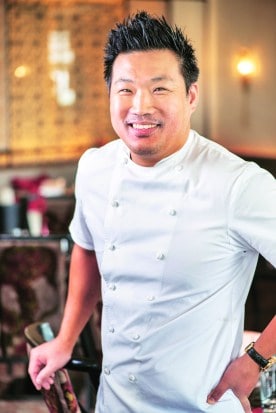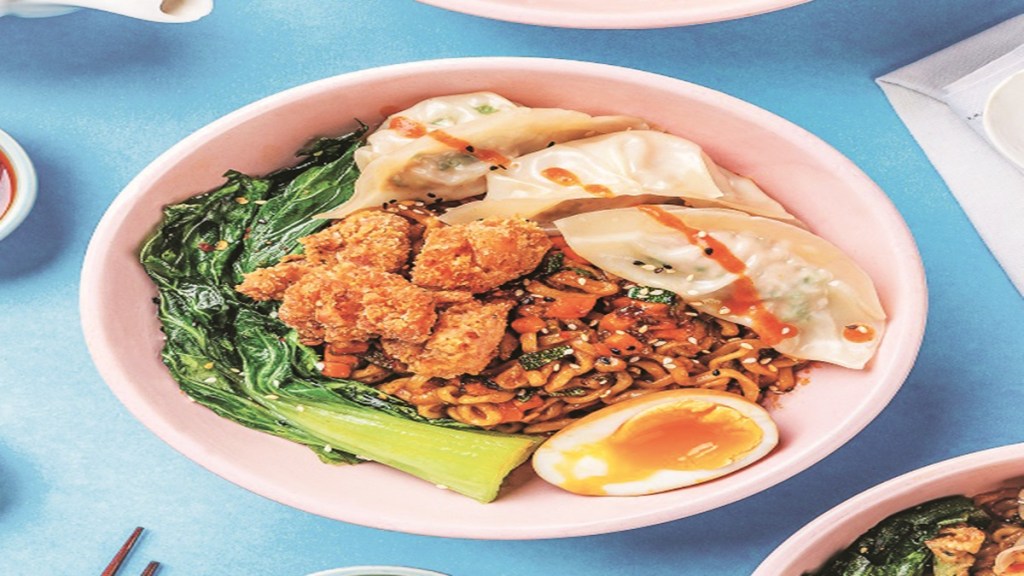Who doesn’t like to have a comforting bowl of ramen with one’s favourite toppings, veggies and meat, especially on a cold, wintry day? However, if those equally-comforting K-dramas have made you believe that ramen is an instant dish, akin to the popular, ‘2-minute’ Maggi instant noodles, you might be in for a surprise. Tracing its origins to the Chinese wheat noodle soups, “Japanese ramen is very gourmet, where most of the ingredients take hours to prepare and are mostly done by hand, and involves a lot of cooking techniques,” explains chef Vidushi Sharma, co-founder of Mensho Tokyo, Delhi, which boasts of an extensive menu around ramen.
At Mensho Tokyo, the medium-bodied broths are stewed for hours and then pulverised. The thickness of the noodles also changes as per the broth. “The thinner noodles work well with a clear broth, and the thicker ones with medium-bodied broths,” adds Sharma.
Interestingly, while nothing tops a large, warm bowl of ramen, the noodle broth dish can be had both hot and cold. depending on the weather. As in India, “in Japan, too, ramen becomes increasingly popular during the colder months. And during summers, what one actually has is ‘somen’, which has lighter noodles with a more refreshing broth. It is even consumed cold there in summers,” says chef Lakhan Jethani, co-founder and head chef at Mizu Izakaya, Mumbai.
Hence, while the Chinese have their wheat-noodle soups, Koreans have ramyun or ramyeon, an instant noodle dish, more of a college student food—quick, cheap and easy. The Japanese ramen, on the other hand, essentially comprises five elements, more like the ‘five heroes’— the ‘men’ (noodles), ‘dashi’ (soup stock), ‘tare’ (sauce), toppings and fat or oil. “A good bowl of ramen is essentially a symphony of these five elements. Each ramen shop in Tokyo or Japan has its own rendition. It’s the ratios and the way you play with these five elements that give individuality to a bowl of ramen and make it like a piece of art,” says Sharma.
This speaks volumes about the versatility of this noodle broth dish that has travelled from China to Japan’s streets, where it was sold at ‘yatai’ or street stalls, before turning into a gourmet food, and further spreading across the globe. So what makes it click as both street and gourmet food? Its humble origins, for one, have contributed immensely to its accessibility and popularity. “Simultaneously, the artistry and complexity involved in crafting gourmet ramen elevate it to a dining experience that appeals to connoisseurs. The diverse range of toppings, broths and textures makes ramen a dynamic dish suitable for various culinary settings,” says Gaurav Kanwar, founder of Harajuku Tokyo Cafe, a Japan-inspired QSR brand with outlets in Delhi-NCR.
People in India normally associate Japanese cuisine with fine-dining and high-end restaurants. However, brands like Harajuku Tokyo Cafe are changing that concept.

While a number of factors have contributed to ramen’s global appeal, the instrumental role was probably played by Taiwanese-Japanese inventor Momofuku Ando, the founder of Nissin Food Products Company, whose Top Ramen is a global hit. In his 2002 autobiography, The Story of the Invention of Instant Ramen, Ando says he got the idea for instant ramen while walking through the rubble-laden streets of Osaka, at a time when Japan was still dealing with the post-war poverty.
“I happened to pass this area and saw a line 20 to 30 metres long in front of a dimly-lit stall from which clouds of steam were steadily rising. People dressed in shabby clothes shivered in the cold while waiting for their turn. The person who was with me said they were lined up for a bowl of ramen,” he wrote. “I realised that people were willing to wait patiently just for a bowl of ramen,” he added. And hence was born the instant ramen.
While Nissin’s Top Ramen is easily available at any store, if you are looking for the quintessential Japanese experience, then there are several eateries available. For example, you can visit Harajuku Tokyo Cafe in the national capital, where you should definitely try the Naruto Ramen (ramen ‘served the way Naruto likes it’). More than anything, the dish proves how the popularity of anime even reflects on ramen. At Harajuku Tokyo Cafe, you can also have the Classic Ramen , Gyoza Ramen (spicy ramen noodles stir fried with exotic veggies, topped with chicken karaage/ shrimp popcorn/ crispy pepper vegetables, vegetable gyozas and pak choi) or the Shoyu and Miso Ramen (with corn, wakame, spring onion, benishoga and blanched spinach).
In Delhi, you can also visit Guppy or Mensho Tokyo. If in Bengaluru, try The Fatty Bao; or Mizu Izakaya and Kofuku in Mumbai. In Kolkata, try the cloud kitchen service called Ramen Kitty.
Another factor that works well for ramen, especially in India, is that while one might take some time to develop a taste for other Japanese food items such as sushi or sashimi, the same is not the case with a ramen bowl. Hence, restaurants don’t have to tailor the flavours much as per the Indian palate, and what one gets is an authentic Japanese culinary experience.
A lot of Indians are also well-travelled now, with Japan being among the top destinations. “So, they have had that authentic experience, and don’t want an Indianised version when they come back. Instead, what they look for is a good, clean, comforting bowl of ramen. Another reason why we don’t alter the flavours is because the Japanese, too, love a spicy version of their ramen, which just fits well with India, and that spicy bowl of noodle soup with amazing meat, a hearty broth just checks all the boxes,” says Jethani of Mizu Izakaya.

Chinese connection
While widely considered a Japanese dish, ramen traces its origins to China. So, when chef Andrew Wong, who runs the Michelin-starred Chinese restaurant A Wong in London and is the mentor chef at Baoshuan, the Chinese restaurant at The Oberoi, Delhi, was in the national capital, we spoke with him about the Chinese origins of this Japanese noodle dish.
The relations between the two countries go back to centuries, but “we know that the Chinese brought cooking with oil into Japan. Before that, they were steaming and boiling, and using other methods of heat; but there was no cooking with oil there. Also, noodles, in most likelihood, travelled from the north of China where noodles and buns are the staple carbohydrates. Notably, there isn’t a particularly long journey from there to Japan,” says the chef.
Much changed after the Second World War. As Japan started rebuilding, it also started to rebrand itself; projecting itself as a soft, and not a hard, power. “They made a very conscious decision of how they wanted to portray themselves on the international scene, and they used gastronomy as an incredible tool to do that. This is why, from the 60s and 70s onwards, there was a massive popularisation of dishes like sushi, sashimi and ramen. And this was the active picture that Japan was painting of itself. And they have done an incredible job. But that doesn’t necessarily make it a historical fact, too,” the chef elucidates, adding that the West, too, played a role in popularising ramen as Japanese.
Despite Japan being the ramen capital of the world now, there still exists a ramen culture in China, especially in its northern parts. “At several places there, if you go to restaurants and ask for rice, they will not have that. They only serve noodles, or buns. It’s an absolutely quintessential part of Chinese gastronomy,” Wong adds.







